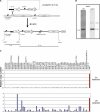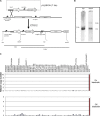Mutually exclusive expression of virulence genes by malaria parasites is regulated independently of antigen production
- PMID: 16518466
- PMCID: PMC1386720
- DOI: 10.1371/journal.ppat.0020022
Mutually exclusive expression of virulence genes by malaria parasites is regulated independently of antigen production
Abstract
The primary virulence determinant of Plasmodium falciparum malaria parasite-infected cells is a family of heterogeneous surface receptors collectively referred to as PfEMP1. These proteins are encoded by a large, polymorphic gene family called var. The family contains approximately 60 individual genes, which are subject to strict, mutually exclusive expression, with the single expressed var gene determining the antigenic, cytoadherent, and virulence phenotype of the infected cell. The mutually exclusive expression pattern of var genes is imperative for the parasite's ability to evade the host's immune response and is similar to the process of "allelic exclusion" described for mammalian Ig and odorant receptor genes. In mammalian systems, mutually exclusive expression is ensured by negative feedback inhibition mediated by production of a functional protein. To investigate how expression of the var gene family is regulated, we have created transgenic lines of parasites in which expression of individual var loci can be manipulated. Here we show that no such negative feedback system exists in P. falciparum and that this process is dependent solely on the transcriptional regulatory elements immediately adjacent to each gene. Transgenic parasites that are selected to express a var gene in which the PfEMP1 coding region has been replaced by a drug-selectable marker silence all other var genes in the genome, thus effectively knocking out all PfEMP1 expression and indicating that the modified gene is still recognized as a member of the var gene family. Mutually exclusive expression in P. falciparum is therefore regulated exclusively at the level of transcription, and a functional PfEMP1 protein is not necessary for viability or for proper gene regulation in cultured parasites.
Conflict of interest statement
Figures







References
-
- Su X, Heatwole VM, Wertheimer SP, Guinet F, Herrfeldt JV, Peterson DS, Ravetch JV, Wellems TE. A large and diverse gene family (var) encodes 200–350 kD proteins implicated in the antigenic variation and cytoadherence of Plasmodium falciparum-infected erythrocytes. Cell. 1995;82:89–100. - PubMed
-
- Baruch DI, Pasloske BL, Singh HB, Bi X, Ma XC, et al. Cloning the P. falciparum gene encoding PfEMP1, a malarial variant antigen and adherence receptor on the surface of parasitized human erythrocytes. Cell. 1995;82:77–87. - PubMed
-
- Kyes S, Horrocks P, Newbold C. Antigenic variation at the infected red cell surface in malaria. Annu Rev Microbiol. 2001;55:673–707. - PubMed
Publication types
MeSH terms
Substances
Grants and funding
LinkOut - more resources
Full Text Sources
Other Literature Sources

